|
시장보고서
상품코드
1576870
세계의 중력 센서 시장 : 유형,소재,용도,최종사용자,기술,출력별 예측(2025-2030년)Gravity Sensors Market by Type (Accelerometers, Gyroscopes, Inclinometers), Material (Magneto-Resistive, MEMS (Microelectromechanical Systems), Quartz), Application, End-User, Technology, Output - Global Forecast 2025-2030 |
||||||
중력 센서 시장은 2023년에 7,843만 달러로 평가되었고, 2024년에는 8,716만 달러에 이를 것으로 예측되며, 복합 연간 성장률(CAGR) 11.43%로 성장하여 2030년에는 1억 6,735만 달러에 달할 것으로 예측됩니다.
중력 센서는 중력을 측정 가능한 신호로 변환하는 데 매우 중요하며 자동차, 항공우주에서 가전 및 건설에 이르기까지 광범위한 산업에서 응용됩니다. 그 필요성은 정밀 측정, 네비게이션 시스템 강화, 지진 분석, 인프라의 건전성 모니터링에 있습니다. 그 응용 범위는 지질 조사에 있어서의 미소한 중력 변화의 검출에서부터 가전제품에 있어서의 스마트폰이나 카메라의 안정화에 이르기까지 다양합니다. 중력 센서는 또한 군사 및 방어와 같은 최종 용도 분야에 사용되어 복잡한 지형에서 전략적 심도를 높이고 있습니다.
| 주요 시장 통계 | |
|---|---|
| 기준년(2023) | 7,843만 달러 |
| 예측년(2024) | 8,716만 달러 |
| 예측년(2030) | 1억 6,735만 달러 |
| 복합 연간 성장률(CAGR)(%) | 11.43% |
시장의 성장을 지지하는 것은 소형화, IoT 기기에의 통합, 공간 인식을 위한 자율주행차에의 채용 확대 등의 기술 진보입니다. 경제 성장과 인프라 정비에 대한 투자 증가는 개발도상 지역 전체 수요를 촉진하고 있습니다. 또한 MEMS(Micro-Electro-Mechanical Systems) 기술의 혁신은 보다 효율적이고 비용 효율적인 중력 센서를 생산할 수 있는 기회를 제공합니다.
이러한 기회에도 불구하고 첨단 센서 기술의 비용이 높고, 극한 상태에서의 기술적 한계, 치열한 경쟁 등의 과제는 시장 성장을 억제할 수 있습니다. 또한, 특정 원료에 대한 의존은 공급망의 취약성을 초래할 수 있습니다.
급성장하는 기회를 활용하기 위해서는 기업은 확장 가능한 제조 기술에 초점을 맞추고 센서의 감도를 높이고 에너지 소비를 줄이기 위해 R&D에 투자해야 합니다. 보완적인 섹터 기업과 협력함으로써 특히 스마트 인프라 및 환경 모니터링 분야에서의 응용 범위를 확대할 수 있습니다. 신소재와 하이브리드 센서 설계 탐구는 경쟁 우위를 제공할 수 있습니다.
시장의 본질은 역동적이며 급속한 기술 진화와 다양한 응용 환경에 밀려 있습니다. 기업은 인프라의 확대와 스마트 시티 환경을 위한 정부의 이니셔티브이 눈에 띄는 신흥국에서의 전략적 제휴와 시장 진입을 우선할 필요가 있습니다. 기술적, 운영적 과제를 해결하고, 지역의 성장 기회를 활용하고, 혁신을 촉진함으로써, 기업은 그 지위를 굳히고 진화하는 중력 센서 시장 전망을 전진시킬 수 있습니다.
시장 역학: 빠르게 진화하는 중력 센서 시장의 주요 시장 인사이트 공개
중력 센서 시장은 수요 및 공급의 역동적인 상호작용에 의해 변모하고 있습니다. 이러한 시장 역학의 진화를 이해함으로써 기업 조직은 충분한 정보를 바탕으로 투자결정, 전략적 결정 정밀화, 새로운 비즈니스 기회를 획득할 수 있습니다. 이러한 동향을 종합적으로 파악함으로써 기업은 정치적, 지리적, 기술적, 사회적, 경제적 영역에 걸친 다양한 위험을 완화할 수 있으며, 소비자 행동과 그것이 제조 비용과 구매 동향에 미치는 영향을보다 명확하게 이해할 수 있습니다.
- 시장 성장 촉진요인
- 석유 및 가스 산업에 있어서의 탐사 활동에의 중력 센서 채용 증가
- 환경 모니터링 및 기후 조사에서 중력 기반 용도의 보급 확대
- 광업, 광물 탐사에 있어서의 중력 센서의 이용 확대
- 지진이나 자연재해의 예측에 있어서의 리얼타임 데이터 취득의 요구의 고조
- 시장 성장 억제요인
- 선진적인 중력 센서의 비용이 높기 때문에 다양한 산업에서의 채용이 제한된다
- 시장 기회
- 중력 센서를 활용한 정밀 농업의 진보에 의한 작물 수량과 자원 관리의 최적화
- 차세대 자율주행차에 중력센서를 통합하여 내비게이션과 안전기능 강화
- 중력 센서의 건설 및 인프라 분야에서의 리얼타임 구조 건전성 모니터링에의 응용 확대
- 시장의 과제
- 중력 센서의 기존 시스템에의 도입은 기술적인 복잡성과 통합의 과제가 가해지고 있습니다.
Porter's Five Forces: 중력 센서 시장을 탐색하는 전략 도구
Porter's Five Forces 프레임 워크는 중력 센서 시장 경쟁 구도를 이해하는 중요한 도구입니다. Porter's Five Forces Framework는 기업의 경쟁력을 평가하고 전략적 기회를 탐구하는 명확한 기술을 제공합니다. 이 프레임워크는 기업이 시장 내 세력도를 평가하고 신규 사업의 수익성을 결정하는 데 도움이 됩니다. 이러한 통찰을 통해 기업은 자사의 강점을 활용하고, 약점을 해결하고, 잠재적인 과제를 피할 수 있으며, 보다 강인한 시장에서의 포지셔닝을 보장할 수 있습니다.
PESTLE 분석 : 중력 센서 시장에서 외부로부터의 영향 파악
외부 거시 환경 요인은 중력 센서 시장의 성과 역학을 형성하는데 매우 중요한 역할을 합니다. 정치적, 경제적, 사회적, 기술적, 법적, 환경적 요인 분석은 이러한 영향을 탐색하는 데 필요한 정보를 제공합니다. PESTLE 요인을 조사함으로써 기업은 잠재적인 위험과 기회를 더 잘 이해할 수 있습니다. 이 분석을 통해 기업은 규제, 소비자 선호, 경제 동향의 변화를 예측하고 앞으로 예상되는 적극적인 의사 결정을 할 준비를 할 수 있습니다.
시장 점유율 분석 중력 센서 시장 경쟁 구도 파악
중력 센서 시장의 상세한 시장 점유율 분석을 통해 공급업체의 성과를 종합적으로 평가할 수 있습니다. 기업은 수익, 고객 기반, 성장률 등 주요 지표를 비교하여 경쟁 포지셔닝을 밝힐 수 있습니다. 이 분석을 통해 시장 집중, 단편화, 통합 동향을 밝혀내고 공급업체는 경쟁이 치열해지면서 자사의 지위를 높이는 전략적 의사 결정을 내리는 데 필요한 지식을 얻을 수 있습니다.
FPNV 포지셔닝 매트릭스 중력 센서 시장에서 공급업체의 성능 평가
FPNV 포지셔닝 매트릭스는 중력 센서 시장에서 공급업체를 평가하는 중요한 도구입니다. 이 행렬을 통해 비즈니스 조직은 공급업체의 비즈니스 전략과 제품 만족도를 기준으로 평가하여 목표에 맞는 충분한 정보를 바탕으로 의사 결정을 내릴 수 있습니다. 네 가지 사분면을 통해 공급업체를 명확하고 정확하게 부문화하고 전략 목표에 가장 적합한 파트너 및 솔루션을 파악할 수 있습니다.
전략 분석 및 권장 중력 센서 시장에서 성공을 위한 길을 그리기
중력 센서 시장의 전략 분석은 시장에서의 존재를 강화하려는 기업에 필수적입니다. 주요 자원, 역량 및 성과 지표를 검토함으로써 기업은 성장 기회를 파악하고 개선을 위해 노력할 수 있습니다. 이러한 접근 방식을 통해 경쟁 구도에서 과제를 극복하고 새로운 비즈니스 기회를 활용하여 장기적인 성공을 거둘 수 있는 체제를 구축할 수 있습니다.
이 보고서는 주요 관심 분야를 포괄하는 시장의 종합적인 분석을 제공합니다.
1. 시장 침투: 현재 시장 환경의 상세한 검토, 주요 기업의 광범위한 데이터, 시장 도달범위 및 전반적인 영향력 평가.
2. 시장 개척도: 신흥 시장의 성장 기회를 파악하고 기존 분야의 확장 가능성을 평가하며 미래 성장을 위한 전략적 로드맵을 제공합니다.
3. 시장 다양화: 최근 제품 출시, 미개척 지역, 업계의 주요 진보, 시장을 형성하는 전략적 투자를 분석합니다.
4. 경쟁 평가 및 정보 : 경쟁 구도를 철저히 분석하여 시장 점유율, 사업 전략, 제품 포트폴리오, 인증, 규제 당국 승인, 특허 동향, 주요 기업의 기술 진보 등을 검증합니다.
5. 제품 개발 및 혁신 : 미래 시장 성장을 가속할 것으로 예상되는 최첨단 기술, R&D 활동, 제품 혁신을 강조합니다.
또한 이해관계자가 충분한 정보를 얻고 의사결정을 할 수 있도록 중요한 질문에 대답하고 있습니다.
1. 현재 시장 규모와 향후 성장 예측은?
2. 최고의 투자 기회를 제공하는 제품, 부문 및 지역은 어디입니까?
3. 시장을 형성하는 주요 기술 동향과 규제의 영향은?
4. 주요 벤더의 시장 점유율과 경쟁 포지션은?
5. 벤더 시장 진입, 철수 전략의 원동력이 되는 수익원과 전략적 기회는 무엇인가?
목차
제1장 서문
제2장 조사 방법
제3장 주요 요약
제4장 시장 개요
제5장 시장 인사이트
- 시장 역학
- 성장 촉진요인
- 석유 및 가스 산업에 있어서의 탐사 활동에 있어서의 중력 센서의 채용 증가
- 환경 모니터링과 기후 연구에서 중력 기반 용도의 보급이 진행되는
- 광업 및 광물 탐사 목적으로 중력 센서의 이용 확대
- 지진이나 자연재해의 예측에 있어서의 실시간 데이터 취득의 필요성 증가
- 억제요인
- 고급 중력 센서의 비용이 높기 때문에 다양한 산업에서의 도입이 제한됩니다.
- 기회
- 작물의 수확량과 자원 관리를 최적화하기 위해 중력 센서를 활용한 정밀 농업의 진보
- 차세대 자율주행차에 중력 센서를 통합하여 내비게이션 기능과 안전 기능을 강화한다
- 실시간 구조 건전성 모니터링을 위한 건설 및 인프라에서 중력 센서의 응용 확대
- 과제
- 기술적 복잡성과 통합 문제, 기존 시스템에 중력 센서의 구현이 지연되었습니다.
- 성장 촉진요인
- 시장 세분화 분석
- Porter's Five Forces 분석
- PESTEL 분석
- 정치적
- 경제
- 사교
- 기술적
- 법률상
- 환경
제6장 중력 센서 시장 : 유형별
- 가속도계
- 자이로스코프
- 경사계
- 자력계
제7장 중력 센서 시장 :소재별
- 자기저항
- MEMS(미소 전기 기계 시스템)
- 석영
제8장 중력 센서 시장 : 용도별
- 항공우주 및 방어
- 미사일 유도
- 네비게이션 시스템
- 자동차
- ADAS(첨단 운전 지원 시스템)(ADAS)
- 전자안정제어(ESC)
- 가전
- 게임 컨트롤러
- 스마트폰
- 웨어러블
- 헬스케어
- 의료기기
- 환자 모니터링
- 산업
- 로봇 공학
- 진동 감시
제9장 중력 센서 시장 : 최종 사용자별
- 애프터마켓
- OEM
제10장 중력 센서 시장 : 기술별
- 아날로그
- 디지털
제11장 중력 센서 시장 출력별
- 현재
- 전압
제12장 아메리카의 중력 센서 시장
- 아르헨티나
- 브라질
- 캐나다
- 멕시코
- 미국
제13장 아시아태평양의 중력 센서 시장
- 호주
- 중국
- 인도
- 인도네시아
- 일본
- 말레이시아
- 필리핀
- 싱가포르
- 한국
- 대만
- 태국
- 베트남
제14장 유럽, 중동 및 아프리카 중력 센서 시장
- 덴마크
- 이집트
- 핀란드
- 프랑스
- 독일
- 이스라엘
- 이탈리아
- 네덜란드
- 나이지리아
- 노르웨이
- 폴란드
- 카타르
- 러시아
- 사우디아라비아
- 남아프리카
- 스페인
- 스웨덴
- 스위스
- 터키
- 아랍에미리트(UAE)
- 영국
제15장 경쟁 구도
- 시장 점유율 분석(2023년)
- FPNV 포지셔닝 매트릭스(2023년)
- 경쟁 시나리오 분석
- 전략 분석과 제안
The Gravity Sensors Market was valued at USD 78.43 million in 2023, expected to reach USD 87.16 million in 2024, and is projected to grow at a CAGR of 11.43%, to USD 167.35 million by 2030.
Gravity sensors, pivotal in translating gravitational force into measurable signals, find broad applications across industries ranging from automotive and aerospace to consumer electronics and construction. Their necessity is anchored in precision measurement, enhancing navigation systems, seismic analysis, and infrastructure health monitoring. The application spectrum spans from detecting minute gravitational changes in geological surveys to stabilizing smartphones and cameras in consumer electronics. Gravity sensors also serve end-use sectors like military and defense, enhancing strategic depth in complex terrains.
| KEY MARKET STATISTICS | |
|---|---|
| Base Year [2023] | USD 78.43 million |
| Estimated Year [2024] | USD 87.16 million |
| Forecast Year [2030] | USD 167.35 million |
| CAGR (%) | 11.43% |
The market's growth is underpinned by technological advancements such as miniaturization, integration into IoT devices, and growing adoption in autonomous vehicles for spatial awareness. Economic growth and increased investment in infrastructure development fuel demand across developing regions. Moreover, innovations in MEMS (Micro-Electro-Mechanical Systems) technology present opportunities for creating more efficient and cost-effective gravity sensors.
Despite these opportunities, challenges such as high costs of advanced sensor technology, technical limitations in extreme conditions, and intense competition might constrain market growth. Additionally, dependence on specific raw materials can create supply chain vulnerabilities.
To capitalize on burgeoning opportunities, businesses must focus on scalable manufacturing techniques and invest in R&D for enhancing sensor sensitivity and reducing energy consumption. Collaborating with firms in complementary sectors can expand application outreach, particularly in smart infrastructure and environmental monitoring. Exploring new materials and hybrid sensor designs can offer competitive advantages.
The market's nature is dynamic, driven by rapid technological evolution and varied application landscapes. Businesses need to prioritize strategic alliances and market entry in emerging economies where infrastructure expansion and government initiatives towards smart city environments are prominent. By addressing technical and operational challenges, leveraging regional growth opportunities, and fostering innovation, companies can solidify their position and drive forward in the evolving gravity sensor market landscape.
Market Dynamics: Unveiling Key Market Insights in the Rapidly Evolving Gravity Sensors Market
The Gravity Sensors Market is undergoing transformative changes driven by a dynamic interplay of supply and demand factors. Understanding these evolving market dynamics prepares business organizations to make informed investment decisions, refine strategic decisions, and seize new opportunities. By gaining a comprehensive view of these trends, business organizations can mitigate various risks across political, geographic, technical, social, and economic domains while also gaining a clearer understanding of consumer behavior and its impact on manufacturing costs and purchasing trends.
- Market Drivers
- Increasing adoption of gravity sensors in the oil and gas industry for exploration activities
- Growing prevalence of gravity-based applications in environmental monitoring and climate studies
- Expanding utilization of gravity sensors for mining and mineral exploration purposes
- Rising need for real-time data acquisition in earthquake and natural disaster prediction
- Market Restraints
- The high cost of advanced gravity sensors limits adoption across various industries
- Market Opportunities
- Advancements in precision agriculture leveraging gravity sensors for optimized crop yield and resource management
- Integration of gravity sensors in next-generation autonomous vehicles for enhanced navigation and safety features
- Expanding applications of gravity sensors in construction and infrastructure for real-time structural health monitoring
- Market Challenges
- Technical complexity and integration challenges slow down the implementation of gravity sensors in existing systems
Porter's Five Forces: A Strategic Tool for Navigating the Gravity Sensors Market
Porter's five forces framework is a critical tool for understanding the competitive landscape of the Gravity Sensors Market. It offers business organizations with a clear methodology for evaluating their competitive positioning and exploring strategic opportunities. This framework helps businesses assess the power dynamics within the market and determine the profitability of new ventures. With these insights, business organizations can leverage their strengths, address weaknesses, and avoid potential challenges, ensuring a more resilient market positioning.
PESTLE Analysis: Navigating External Influences in the Gravity Sensors Market
External macro-environmental factors play a pivotal role in shaping the performance dynamics of the Gravity Sensors Market. Political, Economic, Social, Technological, Legal, and Environmental factors analysis provides the necessary information to navigate these influences. By examining PESTLE factors, businesses can better understand potential risks and opportunities. This analysis enables business organizations to anticipate changes in regulations, consumer preferences, and economic trends, ensuring they are prepared to make proactive, forward-thinking decisions.
Market Share Analysis: Understanding the Competitive Landscape in the Gravity Sensors Market
A detailed market share analysis in the Gravity Sensors Market provides a comprehensive assessment of vendors' performance. Companies can identify their competitive positioning by comparing key metrics, including revenue, customer base, and growth rates. This analysis highlights market concentration, fragmentation, and trends in consolidation, offering vendors the insights required to make strategic decisions that enhance their position in an increasingly competitive landscape.
FPNV Positioning Matrix: Evaluating Vendors' Performance in the Gravity Sensors Market
The Forefront, Pathfinder, Niche, Vital (FPNV) Positioning Matrix is a critical tool for evaluating vendors within the Gravity Sensors Market. This matrix enables business organizations to make well-informed decisions that align with their goals by assessing vendors based on their business strategy and product satisfaction. The four quadrants provide a clear and precise segmentation of vendors, helping users identify the right partners and solutions that best fit their strategic objectives.
Strategy Analysis & Recommendation: Charting a Path to Success in the Gravity Sensors Market
A strategic analysis of the Gravity Sensors Market is essential for businesses looking to strengthen their global market presence. By reviewing key resources, capabilities, and performance indicators, business organizations can identify growth opportunities and work toward improvement. This approach helps businesses navigate challenges in the competitive landscape and ensures they are well-positioned to capitalize on newer opportunities and drive long-term success.
Key Company Profiles
The report delves into recent significant developments in the Gravity Sensors Market, highlighting leading vendors and their innovative profiles. These include Allegro MicroSystems, LLC, Analog Devices, Inc., Bosch Sensortec GmbH, Dytran Instruments, Inc., Hansford Sensors Ltd, Honeywell International Inc., Kionix, Inc., Kistler Group, LORD Sensing Systems, Melexis NV, MEMSIC, Inc., Murata Manufacturing Co., Ltd., NXP Semiconductors, Panasonic Corporation, PCB Piezotronics, Inc., Safran Colibrys, STMicroelectronics, TDK Corporation, TE Connectivity, and Texas Instruments Incorporated.
Market Segmentation & Coverage
This research report categorizes the Gravity Sensors Market to forecast the revenues and analyze trends in each of the following sub-markets:
- Based on Type, market is studied across Accelerometers, Gyroscopes, Inclinometers, and Magnetometers.
- Based on Material, market is studied across Magneto-Resistive, MEMS (Microelectromechanical Systems), and Quartz.
- Based on Application, market is studied across Aerospace and Defense, Automotive, Consumer Electronics, Healthcare, and Industrial. The Aerospace and Defense is further studied across Missile Guidance and Navigation Systems. The Automotive is further studied across Advanced Driver Assistance Systems (ADAS) and Electronic Stability Control (ESC). The Consumer Electronics is further studied across Gaming Controllers, Smartphones, and Wearables. The Healthcare is further studied across Medical Devices and Patient Monitoring. The Industrial is further studied across Robotics and Vibration Monitoring.
- Based on End-User, market is studied across Aftermarket and OEMs.
- Based on Technology, market is studied across Analog and Digital.
- Based on Output, market is studied across Current and Voltage.
- Based on Region, market is studied across Americas, Asia-Pacific, and Europe, Middle East & Africa. The Americas is further studied across Argentina, Brazil, Canada, Mexico, and United States. The United States is further studied across California, Florida, Illinois, New York, Ohio, Pennsylvania, and Texas. The Asia-Pacific is further studied across Australia, China, India, Indonesia, Japan, Malaysia, Philippines, Singapore, South Korea, Taiwan, Thailand, and Vietnam. The Europe, Middle East & Africa is further studied across Denmark, Egypt, Finland, France, Germany, Israel, Italy, Netherlands, Nigeria, Norway, Poland, Qatar, Russia, Saudi Arabia, South Africa, Spain, Sweden, Switzerland, Turkey, United Arab Emirates, and United Kingdom.
The report offers a comprehensive analysis of the market, covering key focus areas:
1. Market Penetration: A detailed review of the current market environment, including extensive data from top industry players, evaluating their market reach and overall influence.
2. Market Development: Identifies growth opportunities in emerging markets and assesses expansion potential in established sectors, providing a strategic roadmap for future growth.
3. Market Diversification: Analyzes recent product launches, untapped geographic regions, major industry advancements, and strategic investments reshaping the market.
4. Competitive Assessment & Intelligence: Provides a thorough analysis of the competitive landscape, examining market share, business strategies, product portfolios, certifications, regulatory approvals, patent trends, and technological advancements of key players.
5. Product Development & Innovation: Highlights cutting-edge technologies, R&D activities, and product innovations expected to drive future market growth.
The report also answers critical questions to aid stakeholders in making informed decisions:
1. What is the current market size, and what is the forecasted growth?
2. Which products, segments, and regions offer the best investment opportunities?
3. What are the key technology trends and regulatory influences shaping the market?
4. How do leading vendors rank in terms of market share and competitive positioning?
5. What revenue sources and strategic opportunities drive vendors' market entry or exit strategies?
Table of Contents
1. Preface
- 1.1. Objectives of the Study
- 1.2. Market Segmentation & Coverage
- 1.3. Years Considered for the Study
- 1.4. Currency & Pricing
- 1.5. Language
- 1.6. Stakeholders
2. Research Methodology
- 2.1. Define: Research Objective
- 2.2. Determine: Research Design
- 2.3. Prepare: Research Instrument
- 2.4. Collect: Data Source
- 2.5. Analyze: Data Interpretation
- 2.6. Formulate: Data Verification
- 2.7. Publish: Research Report
- 2.8. Repeat: Report Update
3. Executive Summary
4. Market Overview
5. Market Insights
- 5.1. Market Dynamics
- 5.1.1. Drivers
- 5.1.1.1. Increasing adoption of gravity sensors in the oil and gas industry for exploration activities
- 5.1.1.2. Growing prevalence of gravity-based applications in environmental monitoring and climate studies
- 5.1.1.3. Expanding utilization of gravity sensors for mining and mineral exploration purposes
- 5.1.1.4. Rising need for real-time data acquisition in earthquake and natural disaster prediction
- 5.1.2. Restraints
- 5.1.2.1. The high cost of advanced gravity sensors limits adoption across various industries
- 5.1.3. Opportunities
- 5.1.3.1. Advancements in precision agriculture leveraging gravity sensors for optimized crop yield and resource management
- 5.1.3.2. Integration of gravity sensors in next-generation autonomous vehicles for enhanced navigation and safety features
- 5.1.3.3. Expanding applications of gravity sensors in construction and infrastructure for real-time structural health monitoring
- 5.1.4. Challenges
- 5.1.4.1. Technical complexity and integration challenges slow down the implementation of gravity sensors in existing systems
- 5.1.1. Drivers
- 5.2. Market Segmentation Analysis
- 5.3. Porter's Five Forces Analysis
- 5.3.1. Threat of New Entrants
- 5.3.2. Threat of Substitutes
- 5.3.3. Bargaining Power of Customers
- 5.3.4. Bargaining Power of Suppliers
- 5.3.5. Industry Rivalry
- 5.4. PESTLE Analysis
- 5.4.1. Political
- 5.4.2. Economic
- 5.4.3. Social
- 5.4.4. Technological
- 5.4.5. Legal
- 5.4.6. Environmental
6. Gravity Sensors Market, by Type
- 6.1. Introduction
- 6.2. Accelerometers
- 6.3. Gyroscopes
- 6.4. Inclinometers
- 6.5. Magnetometers
7. Gravity Sensors Market, by Material
- 7.1. Introduction
- 7.2. Magneto-Resistive
- 7.3. MEMS (Microelectromechanical Systems)
- 7.4. Quartz
8. Gravity Sensors Market, by Application
- 8.1. Introduction
- 8.2. Aerospace and Defense
- 8.2.1. Missile Guidance
- 8.2.2. Navigation Systems
- 8.3. Automotive
- 8.3.1. Advanced Driver Assistance Systems (ADAS)
- 8.3.2. Electronic Stability Control (ESC)
- 8.4. Consumer Electronics
- 8.4.1. Gaming Controllers
- 8.4.2. Smartphones
- 8.4.3. Wearables
- 8.5. Healthcare
- 8.5.1. Medical Devices
- 8.5.2. Patient Monitoring
- 8.6. Industrial
- 8.6.1. Robotics
- 8.6.2. Vibration Monitoring
9. Gravity Sensors Market, by End-User
- 9.1. Introduction
- 9.2. Aftermarket
- 9.3. OEMs
10. Gravity Sensors Market, by Technology
- 10.1. Introduction
- 10.2. Analog
- 10.3. Digital
11. Gravity Sensors Market, by Output
- 11.1. Introduction
- 11.2. Current
- 11.3. Voltage
12. Americas Gravity Sensors Market
- 12.1. Introduction
- 12.2. Argentina
- 12.3. Brazil
- 12.4. Canada
- 12.5. Mexico
- 12.6. United States
13. Asia-Pacific Gravity Sensors Market
- 13.1. Introduction
- 13.2. Australia
- 13.3. China
- 13.4. India
- 13.5. Indonesia
- 13.6. Japan
- 13.7. Malaysia
- 13.8. Philippines
- 13.9. Singapore
- 13.10. South Korea
- 13.11. Taiwan
- 13.12. Thailand
- 13.13. Vietnam
14. Europe, Middle East & Africa Gravity Sensors Market
- 14.1. Introduction
- 14.2. Denmark
- 14.3. Egypt
- 14.4. Finland
- 14.5. France
- 14.6. Germany
- 14.7. Israel
- 14.8. Italy
- 14.9. Netherlands
- 14.10. Nigeria
- 14.11. Norway
- 14.12. Poland
- 14.13. Qatar
- 14.14. Russia
- 14.15. Saudi Arabia
- 14.16. South Africa
- 14.17. Spain
- 14.18. Sweden
- 14.19. Switzerland
- 14.20. Turkey
- 14.21. United Arab Emirates
- 14.22. United Kingdom
15. Competitive Landscape
- 15.1. Market Share Analysis, 2023
- 15.2. FPNV Positioning Matrix, 2023
- 15.3. Competitive Scenario Analysis
- 15.4. Strategy Analysis & Recommendation
Companies Mentioned
- 1. Allegro MicroSystems, LLC
- 2. Analog Devices, Inc.
- 3. Bosch Sensortec GmbH
- 4. Dytran Instruments, Inc.
- 5. Hansford Sensors Ltd
- 6. Honeywell International Inc.
- 7. Kionix, Inc.
- 8. Kistler Group
- 9. LORD Sensing Systems
- 10. Melexis NV
- 11. MEMSIC, Inc.
- 12. Murata Manufacturing Co., Ltd.
- 13. NXP Semiconductors
- 14. Panasonic Corporation
- 15. PCB Piezotronics, Inc.
- 16. Safran Colibrys
- 17. STMicroelectronics
- 18. TDK Corporation
- 19. TE Connectivity
- 20. Texas Instruments Incorporated



















